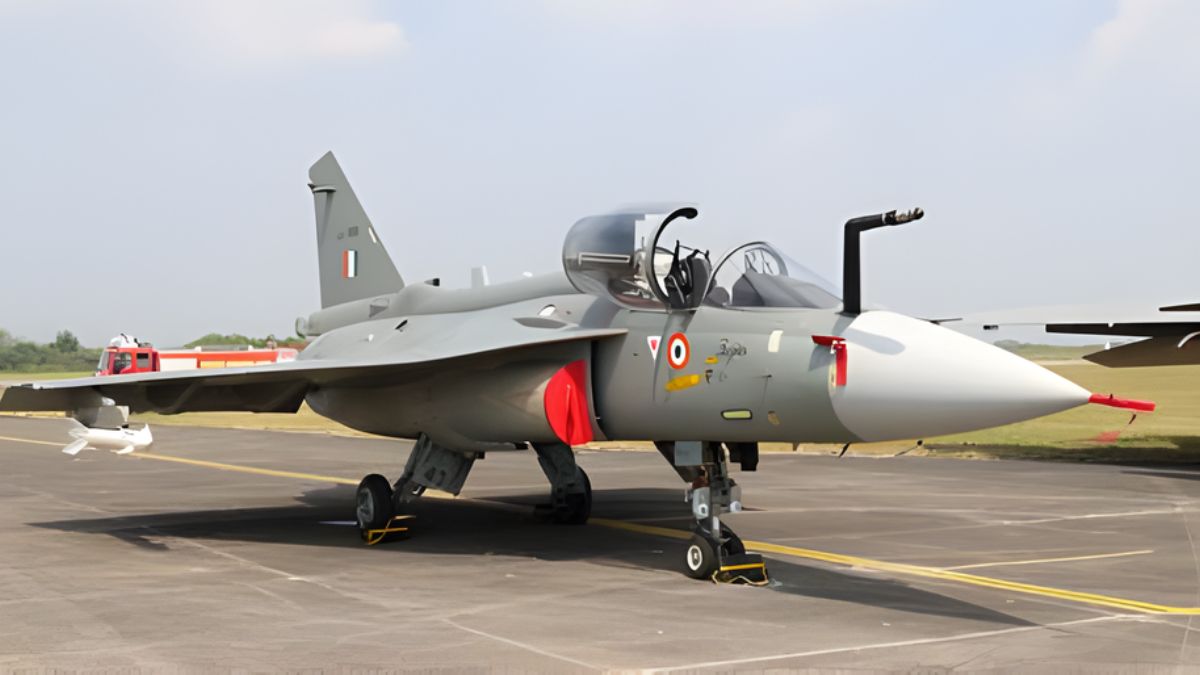Days After MiG-21 Farewell, LCA Tejas Mk1A Jet Takes Maiden Flight: Made In India Addition To IAF’s Air Power

HAL has operationalised the third LCA Mk1A production line in a record time of two years. Image courtesy: PIB
Less than a month after Indian Air Force decommissioned the Soviet era MiG-21, the IAF seems a step closer to inducting its India-made replacement. On Friday (October 17, 2025), history was written in a way as Defence Minister Rajnath Singh flagged off the maiden flight of the Light Combat Aircraft (LCA) Tejas Mk1A.
Piloted by HAL’s Chief Test Pilot Group Captain KK Venugopal (Retd), the LCA Tejas Mk 1A also received a water cannon salute after its maiden test flight. Notably, HAL initiated the establishment of the third production line in order to fast-track delivery of LCA Tejas aircraft to the Indian Air Force.
Giving further wings to India’s flight towards defence self-reliance, Defence Minister Singh inaugurated two new aircraft production lines at Hindustan Aeronautics Limited’s (HAL) Nashik facility, the third line for the LCA Tejas Mk1A and the second for the Hindustan Turbo Trainer-40 (HTT-40).
Indigenous defence production: How is the sector transforming?
In a ceremony attended by senior military, government, and industry officials, Singh described the indigenously designed Tejas as “a shining symbol of India’s growing self-reliance in defence.” He noted that in just a decade, the country had reversed its dependence on foreign suppliers.
India has now shifted from importing nearly 70% of its critical military hardware to producing 65% of it domestically. The government, the minister said, was determined to reach “100% domestic manufacturing in the years ahead.”
Singh has credited policy reforms and private sector participation for reshaping India’s military-industrial base. “When we came to power in 2014, we realised that without self-reliance, we can never be truly secure,” he said, recalling a time when “limited defence preparedness” and “import dependency” left India vulnerable.
Singh emphasised that India’s new approach, marked by indigenisation, innovation, and joint public-private collaboration, had turned that challenge into an opportunity. Citing data, he said that India’s annual defence production had risen from Rs 46,429 crore in 2014–15 to over Rs 1.5 lakh crore in 2024–25, with exports touching an all-time high of Rs 25,000 crore.
The next goal, he announced, was to double those figures, reaching Rs 3 lakh crore in total production and Rs 50,000 crore in exports by 2029.
What does the Nashik expansion mean for India’s aerospace ambitions?
HAL’s Nashik facility, a cornerstone of Indian aircraft manufacturing since 1964, now houses the new Tejas and HTT-40 production lines, both fully indigenised platforms designed for the Indian Air Force. The new Tejas line, built in record time over two years, can produce eight aircraft annually, raising HAL’s total Tejas output to 24 per year.
The HTT-40 line, meanwhile, will support the assembly of the basic trainer aircraft for the Air Force, manufacturing key components such as fuselage, wings, and control surfaces.
HAL’s Chairman and Managing Director, Commodore (Retd) Girideep Singh, called the achievement “a proud moment” for the organisation. “Achieving Mini Ratna status reflected the dedication and commitment of our workforce,” he said, adding that the Nashik division’s expansion has already created about 1,000 new jobs.
Tejas programme: Why is it central to India’s defence future?
The Tejas Mk1A, developed jointly by HAL, the Aeronautical Development Agency, and the Indian Air Force, represents the most advanced fighter ever produced in India. Defence Secretary Sanjeev Kumar described it as “not merely a fighter aircraft, but a statement of India’s design and manufacturing excellence.”
The HTT-40, developed entirely by HAL, was similarly lauded as proof of India’s ability to conceptualise and deliver complex defence platforms without foreign assistance.
Defence Minister Singh urged HAL to continue innovating beyond the Tejas and HTT-40 programmes, particularly in the fields of artificial intelligence, unmanned systems, and next-generation aircraft. He also praised HAL for its contribution during Operation Sindoor, when Nashik engineers integrated BrahMos missiles onto Su-30MKI fighters used to strike terrorist hideouts. As Singh put it, HAL’s Nashik campus, once known for producing MiG-21s and Su-30s — now stands as a symbol of a transformed India, a nation no longer content to buy its security, but to build it.







